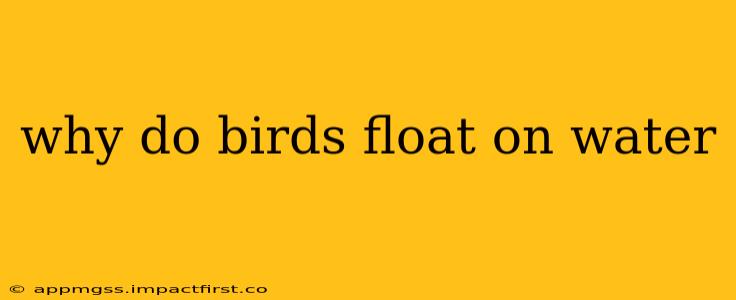Birds' ability to float on water is a fascinating example of natural engineering, a marvel of physics and biology working in perfect harmony. While it might seem magical, the secret lies in a combination of factors: their body composition, feather structure, and skillful paddling. Let's dive into the specifics.
What Makes Birds Buoyant?
The primary reason birds float is their low density compared to water. This isn't just about their weight; it's about the ratio of their weight to their volume. Think of it like a large, lightweight balloon versus a small, heavy rock. The balloon, despite being larger, is less dense and floats, whereas the rock, denser, sinks. Birds achieve this low density through a few key mechanisms:
-
Lightweight Bones: Many bird bones are hollow, filled with air sacs instead of bone marrow. This significantly reduces their overall weight without compromising structural integrity. This air-filled bone structure is crucial for flight, but it also contributes to buoyancy.
-
Air Sacs: Birds possess a complex system of air sacs that extend throughout their bodies, further reducing density. These air sacs are part of their respiratory system but also play a significant role in weight management and buoyancy.
-
Feathers: Feathers, while seemingly light, trap air, increasing the bird's overall volume without adding much weight. This trapped air adds to the bird's buoyancy. The oily coating on many bird feathers also aids in water repellency, preventing them from getting waterlogged and heavy.
How Do Different Birds Float?
While the fundamental principles remain the same, different bird species exhibit varying degrees of buoyancy and employ different strategies. Waterfowl, like ducks and geese, are especially adept at floating. Their large, webbed feet provide propulsion and stability on the water's surface. Their plumage is particularly dense and well-insulated, providing excellent buoyancy and warmth. Smaller birds, on the other hand, might struggle to stay afloat for extended periods, relying more on their paddling skills.
How Do Birds Stay Afloat in Rough Water?
This question touches on the importance of a bird's overall body control and equilibrium. Even in choppy waters, many birds maintain their buoyancy thanks to:
-
Specialized Feet and Legs: Webbed feet offer increased surface area for propulsion and stability, allowing birds to maintain their position on the water's surface even in rough conditions.
-
Body Posture: Birds often adjust their body posture, keeping their center of gravity low to counteract the movement of the waves.
-
Muscular Strength: Birds have strong leg and pectoral muscles that enable them to maintain their balance and position in the water, compensating for wave action.
Can All Birds Float?
While most birds possess characteristics that contribute to buoyancy, not all birds float equally well. Some birds, particularly those adapted to land-based lifestyles or those that spend less time on water, will have less buoyancy. They might even struggle to stay afloat.
Why Don't Birds Sink When They Dive?
This is an excellent point that highlights the dynamic nature of bird buoyancy. Birds can control their buoyancy by adjusting their posture, wing position, and the amount of air they trap in their feathers. When diving, they often actively compress their feathers to reduce air pockets and increase density, aiding their descent. Upon surfacing, they resume their normal posture and feather arrangement, regaining buoyancy.
This exploration of avian buoyancy demonstrates the intricate interplay between anatomy, physiology, and behavior that allows birds to navigate aquatic environments effectively. It's a testament to the elegance and efficiency of natural selection.
